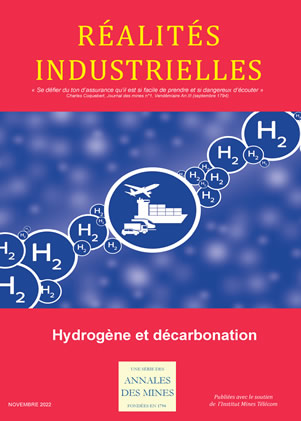| |

|
|
 Novembre 2022 - Hydrogène et décarbonation Novembre 2022 - Hydrogène et décarbonation
Decoupled Water Splitting for Green Hydrogen Production: Reshaping Water Electrolysis
By Avner ROTHSCHILD
Department of Materials Science and Engineering, Technion – Israel Institute of Technology, Haifa, Israel
Hen DOTAN
H2Pro, 2 Ha-Tokhen street, Caesarea Business and Industrial Park, Israel
And
Gideon GRADER
Department of Chemical Engineering, Technion – Israel Institute of Technology, Haifa, Israel
Green hydrogen production at scale is essential to fight global warming and climate change. The present water electrolysis technologies present significant barriers to meet this challenge, due to high system and operational costs that emerge from the need to divide each cell into gas-tight cathodic and anodic compartments to avoid mixing hydrogen with oxygen, and from intrinsic energy losses in the complex oxygen evolution reaction. Recent efforts to overcome these barriers include transformative approaches to decouple the hydrogen and oxygen evolution reactions using soluble redox couples or solid redox electrodes that mediate the ion exchange between the primary electrodes such that hydrogen and oxygen are generated at different times and/or different cells. This leads the way to membraneless electrolyzer architectures that can enhance safety, reduce system costs, and provide operational advantages such as high-pressure hydrogen production. In particular, E-TAC water slitting offers these advantages as well as ultrahigh efficiency and compact design of rolled electrode assemblies, opening new frontiers for advanced water electrolysis.
 Télécharger gratuitement l'article Télécharger gratuitement l'article
 Retour au sommaire Retour au sommaire
 November 2022 - Hydrogen and decarbonation November 2022 - Hydrogen and decarbonation
Decoupled Water Splitting for Green Hydrogen Production: Reshaping Water Electrolysis
Avner Rothschild,
Department of Materials Science and Engineering, Technion – Israel Institute of Technology, Haifa, Israel,
Hen Dotan,
H2Pro, 2 Ha-Tokhen street, Caesarea Business and Industrial Park, Israel,
and
Gideon Grader,
Department of Chemical Engineering, Technion – Israel Institute of Technology, Haifa, Israel
Green hydrogen production at scale is essential to fight global warming and climate change. The present water electrolysis technologies present significant barriers to meet this challenge, due to high system and operational costs that emerge from the need to divide each cell into gas-tight cathodic and anodic compartments to avoid mixing hydrogen with oxygen, and from intrinsic energy losses in the complex oxygen evolution reaction. Recent efforts to overcome these barriers include transformative approaches to decouple the hydrogen and oxygen evolution reactions using soluble redox couples or solid redox electrodes that mediate the ion exchange between the primary electrodes such that hydrogen and oxygen are generated at different times and/or different cells. This leads the way to membraneless electrolyzer architectures that can enhance safety, reduce system costs, and provide operational advantages such as high-pressure hydrogen production. In particular, E-TAC water slitting offers these advantages as well as ultrahigh efficiency and compact design of rolled electrode assemblies, opening new frontiers for advanced water electrolysis.
 Download full article Download full article
 Retour au sommaire Retour au sommaire
|
|




